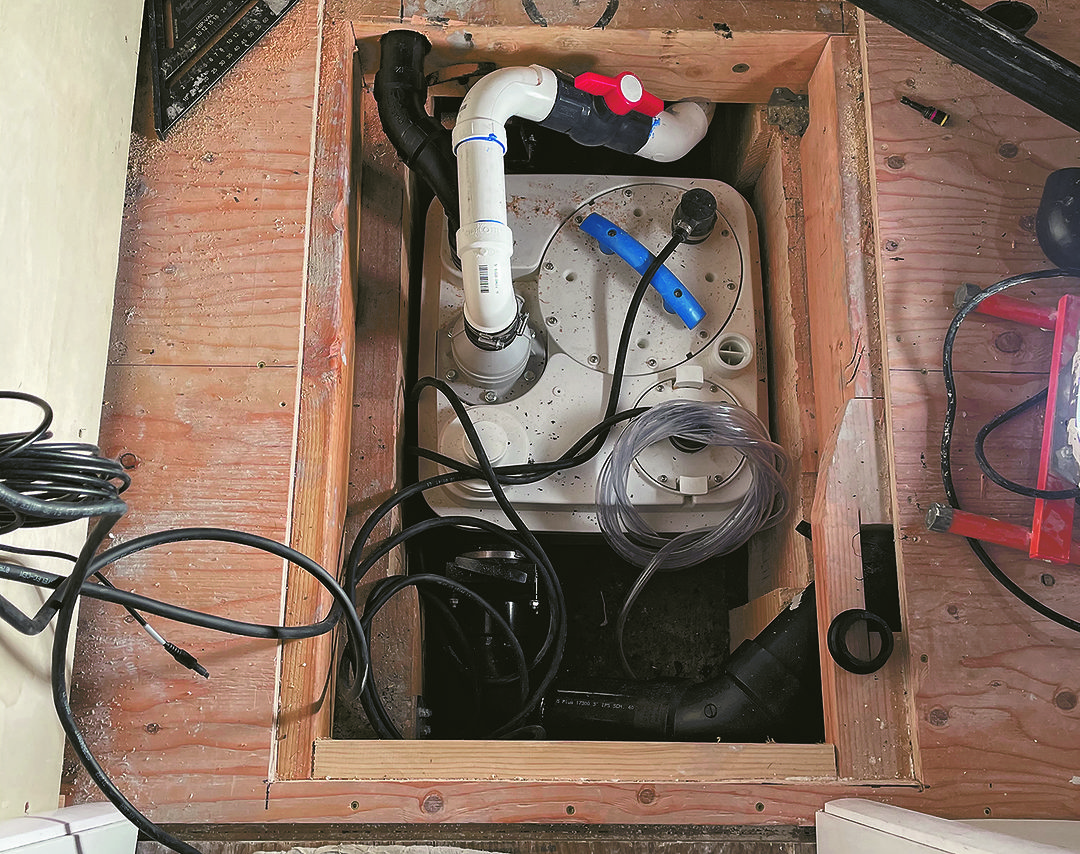Saniflo Sanicubic 1 Provides Drainage Solution for Floating Home
AR Plumbing avoids the costly job of busting through a concrete foundation to install plumbing for a full bathroom and washing machine.

A floating home is a building, ranging from a tiny house to a four-story home, that floats on a body of water. Unlike a houseboat, a floating home is meant to be moved just once, placed on a floating concrete foundation, and permanently connected to public utilities; i.e., floating homes are permanently connected to municipal sewer, water, and electrical.
Installing conventional plumbing on a floating home can present some unique and formidable challenges. That’s why the owner of a floating house located at the main dock area of Richardson Bay in Sausalito, California, enlisted the help of an engineer and a local professional plumbing company, AR Plumbing. The project’s scope involved installing the plumbing for a toilet, shower, sink and washing machine as part of remodeling the floating home.
Based in San Rafael, California, AR Plumbing handles residential and light-commercial plumbing projects. According to owner and CEO Adelso Rodas, his two-person crew could not bust through the floating home’s concrete foundation to install conventional plumbing because of steel beams running through the concrete.
“Our engineer advised against it, because it would compromise the integrity of the concrete slab,” Rodas says.
Thus, AR was tasked with finding an alternative, less costly method for draining the toilet, sink, shower, and washing machine.
Above-floor solution
Having installed a Saniflo macerating toilet in another floating house, Rodas recommended Saniflo’s above-floor plumbing solution to the engineer.
“After talking to one of Saniflo’s regional sales managers, we identified the Sanicubic 1 as the right product for the application,” Rodas says.
The Sanicubic 1 is a pre-assembled simplex (single pump) grinder system, capable of discharging wastewater from multiple fixtures. Shipped fully assembled, the compact, heavy-duty lift station can move up to 50 gallons of effluent per minute. In addition, the highly durable plastic enclosure for its pump and grinding blade incorporates four different exterior inlets for incoming waste lines, as well as sophisticated controls and a monitoring system to mitigate servicing issues.
“We initially looked into installing a pump from another manufacturer,” Rodas adds, “but it would have been a difficult installation. The Sanicubic 1, however, is easier to install and way more compact.”
The system is designed for applications where the sewer line or the septic tank sits above or away from the structure. With its four inlets that can accommodate 1-½-inch or 4-inch diameter pipe, the Sanicubic 1 offers greater piping layout flexibility, which is ideal for the highly confined spaces of a floating home.
Featuring a one-horsepower motor and a fast-rotating, stainless-steel cutting blade, the Sanicubic 1 minimizes the possibility of clogs by quickly reducing solids — including larger sanitary products — into a slurry that can be pumped up to 36 feet vertically or 328 feet horizontally through a 1.5-inch, rigid pipe.
The installation
Here’s how Rodas and his installation team built the plumbing system on the floating home:
- The Sanicubic 1 was positioned in a small space under the floating home’s wooden floorboard.
- Rodas and his team used two of the four inlets on the Sanicubic 1.
- A 2-inch drain line from the shower and laundry room runs 12 feet before feeding into one of the Sanicubic inlets.
- A second, 3-inch drain line, coming from the toilet and sink, runs 14 feet before feeding into a second Sanicubic inlet.
- Drainage from the four fixtures is jettisoned from the Sanicubic 1 through a 1.5-inch PVC (Schedule 80) discharge pipe. This pipe is connected to the top of the unit and runs 25 feet before discharging into the municipal sewage access, located on the dock.
According to Rodas, the entire installation, including running drainage lines from the four fixtures, took only two days. After multiple tests, Rodas reports that the completed system is performing well.
Saniflo was the only realistic alternative to conventional plumbing on the current market, according to Rodas, especially for a unique and demanding application like a floating home.
Jose Pachas is the technical manager at Saniflo, and he can be reached at jpachas@saniflo.com.




